In an effort to bring this blog back up to date, I'm going to amalgamate several days' worth of Hampshire plant-bothering into one blogpost. I'll try to keep it concise...
Thursday 27th January was spent in the New Forest looking at some rare fungi and finding a pretty smart alien flatworm in leaf litter. We headed to Ridley Wood where we noted a few decent species, though the plants themselves were somewhat less interesting. Note the 'absent' ground flora in the middle image below - those bloody ponies definitely need to be culled!
 |
| Gorse Spider Mite webs all over Gorse bushes |
 |
| A great habitat for saproxylics and decomposers! |
 |
| Fallen beechmast is the sole host for the tiny Xylaria carpophila. Weird but true |
 |
| Grand Fir Abies grandis. Note the real needle in the second pic |
Further into the woods we started finding small seedlings of a different conifer species. Happily they keyed through without any difficulty, another yeartick though not a lifer for either of us
 |
| This is Lawson's Cypress Cupressus lawsoniana. Note the mine in the bottom image |
The mine is caused by a tiny moth, the larvae of which bore into and then consume the contents of the leaf scales. There are two species of moth that do this in Britain, and you'd need to rear the larva through to adulthood to be sure of the identity. However, seeing as this is on Lawson's Cypress and not Leyland Cypress, I think Argyresthia trifasciata is the more likely of the two. Ghostie will doubtless disagree with me, he does like to pretend he knows a thing or two about moffs...
 |
| A fine example of Polypodium interjectum. Note how the outer sori are ovoid rather than rounded |
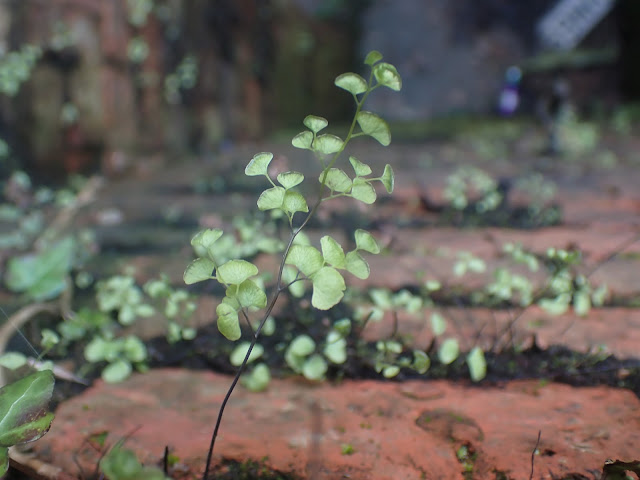 |
| Maidenhair Fern Adiantum capillus-veneris - I definitely won't see this when I'm back in Scotland! |
 |
| Mistletoe Viscum album clearly doing exceptionally well in this part of Hampshire! |
We hit Gosport on 29th January, though it failed to deliver several species that were initially on our radar. However, we stumbled across a healthy patch of Wood Small-reed which was an unexpected bonus
 |
| Wood Small-reed Calamagrostis epigejos - a little past its best but still perfectly key-able |
Other plants of note around Gosport were Equal-leaved Knotgrass, Hoary Plantain and Large Bindweed, which despite not having any flowers still managed to key through convincingly. Once again I feel the need to say that Poland's Veg Key is a truly marvellous piece of work.
Heading inland we visited several sites, hoping to take shelter from the chill wind in tall woodlands. We were on the chalk, so the flavour of plants changed somewhat. Wayfaring-tree and Common Whitebeam quickly threw themselves onto our lists at Head Down, but no sign of the Common Gromwell (edge mowed) or Deadly Nightshade (presumably not visible in the winter months) that we'd seen here on a previous visit several years back.
 |
| Wayfaring-tree Viburnum lantana terminal bud |
The woods, in all honesty, were pretty dead. Probably something to do with it being a chilly day in late January... We changed tack and headed towards a village pond that The Ghost knows so I could yeartick some clearly planted and hence uncountable Hybrid Crack-willows. He tried to persuade me to add some equally dodgy Lesser Periwinkle in a flowerbed to my yearlist. Happily I resisted on both counts, though I sure as hell counted the flowering Winter Aconite I spotted as soon as we entered the village churchyard!
 |
| Winter Aconite Eranthis hyemalis - just the second time I've encountered this delightful plant |
Ghostie was instantly full of cheer and grins, finding Winter Aconite was not in our minds, so to unexpectedly stumble into this little clump was a sheer delight. We took a few piccies and checked what the book had to say about them before I heard a smiling Ghostie say "that's absolutely made my day". Blimey, was he feeling alright? I didn't even know he could smile!
Our last site for the day was Petersfield Lake so I could fill my boots with "utter dross" like Mute Swan, Greylag Goose, Tufted Duck and, worst of all, Egyptian Geese. We do have small numbers of Tufties overwinter on Skye, but Mute Swan would cause a stampede were one to turn up. However, we still found a few plants of interest (of interest to me, at least), the best of which was this stunner
This is Greater Celandine Chelidonium majus, completely absent from the Skye area and a plant I was very much hoping to catch up with. The yellow sap was used by the Victorians in rather an interesting way; it was used as a beautification agent, dab it into a lady's eye and her whites would brighten, seemingly an appealing feature back in the day. However, over-dabbing could lead to permanent blindness. Bit risky if you ask me, and I wonder how many blinded ladies it took before they realised what was happening. I didn't try it out for myself and Ghostie didn't offer his eyes when I told him of its remarkable attributes. Such a wuss.
Sunday 30th January was our Big Day. First up was Port Solent near Portsmouth for a couple of highly desirable plants. The first grows between paving cracks in a certain car park. Rather annoyingly, from our perspective, the car park in question was out of bounds for the day thanks to a car show that was taking place. We were denied access by a marshall, Ghostie traded a few choice words with the guy, and we roared off to another carpark to try our luck there. Happily, our target plant was soon found and all grievances were quickly forgotten.
 |
| Small Goosegrass (aka Small Cleavers) Galium murale with Cleavers alongside for scale |
 |
| This is Thick-leaved Stonecrop Sedum dasyphyllum - it's certainly a bit of a chunky monkey! |
We took a brief wander around Milton Common, but the time of year was wrong for our target plants and brambles have seemingly smothered the Grape-vine. Luckily we bagged Ribbed Melilot and Tall Melilot, both of which are decidedly uncommon and scattered north of the border.
We quit Portsmouth, never a bad thing, and headed to Portsdown Hill, home of at least a thousand species of Cotoneaster. Or so it seems, once you're in there. We had old gen for some of them, the main problem being that ongoing scrub clearance and grazing may have destroyed some of the plants we were after. We set off regardless, hoping for a clean sweep but ready to admit defeat if need be. As it transpired, we saw over half the species we tried for.
The Cotoneasters came thick and fast once we were in The Zone. Armed with Stace 4 and Poland's Veg Key, plus a copy of the Hants Flora Cotoneaster Crib, we confidently named some, wavered back and forth over others and basically threw our arms in the air with frustration at others. Six years ago we did this very same Cotoneaster circuit and we cleared up. This time, with more knowledge and better books, we were definitely struggling. Admittedly berries were at a premium and some species were mostly lacking leaves, but it seemed much more of a slog this time around. Random leaf pics below, what do you reckon they are?
Species we were happy with included Cotoneaster x watereri, C.sternianus, C.simonsii, C.divaricatus, C.lacteus, C.salicifolius and I'm pretty sure we also had C.dielsianus and possibly C.vilmorianus. Others were either no longer there, engulfed in thorn scrub or we missed them/didn't try for them. As you can see from the pictures, the weather was truly gorgeous. I was sweating in my hoodie, the coat had long since been bundled into my rucksack. Which probably explains why we found Wild Parsnip in flower. In January....!
We had one last target to check, and we were by now starting to lose daylight. Ghostie was keen. I was keen. We headed off to yet another churchyard. I swear I've spent more time in churchyards this month than does the average priest. Our target was not a plant, but a fungus. Ordinarily I wouldn't besmirch this blog with such a thing, but this one was rather tasty. Not literally! This particular fungus is fully protected by law, so no tasting allowed. Curiously, it was growing inside the base of a gigantic Yew tree! Behold, I give you the rare Sandy Stiltball. And some knobber with his head stuck in a tree.
 |
| Honestly, the man knows no shame..... |
I ended the day with 368 plant species for the year, far more than I'd hoped to achieve for the opening month of the year. I would start to plateau soon, how much longer could I keep up this ridiculous rate I wondered. Happily, with just one more day left in Hampshire, there was still some juice in the tank.
Monday 31st January saw us drive in convoy into mid-Hampshire for The Ghost to put his car in for service. I'd buzz us around all day until his car was ready, we had a few sites in mind but, after ten days, we were pretty much scraping the barrel for fresh ideas. We both agreed that January was not the ideal time of year for botanising Hampshire.
We visited various sites, crossing into West Sussex for a few hours, finally finding Alder Buckthorn (a big relief for me, it's a very scarce plant in Scotland), Least Duckweed, Deutzia scabra and, by the skin of our teeth, Large Thyme in yet another churchyard
 |
| Large Thyme Thymus pulegioides alongside Wild Thyme Thymus polytrichus. It's the very hairy one |
Next we hit Midhurst and decided to just amble around the pond area then the backstreets in the older part of the town. I'm not particularly familiar with Midhurst, but Ghostie knows it well. He planned to add Mexican Fleabane to my yearlist, with luck. Er yeah, I'd say luck was with us!
 |
| Mexican Fleabane Erigeron karvinskianus - sorted! |
Continuing along the road we arrived at the pond. Loads of Alder Leaf Beetles overwintering in the fissured bark of a large ornamental conifer were a surprise. They really have expanded their range these past few years. More interesting, especially to Ghostie, was the large thicket of bamboo growing alongside a stream. Damnit, it was one I'd seen in Fife just ten days earlier, not even a yeartick. Worse still, it was a lifer for Ghostie. And did he gloat? Of course he bloody did!
 |
| This is Broad-leaved Bamboo Sasa palmata. Not a lifer (for some) |
We were finding all sorts of interesting plants along this stretch of stream. Hemlock Water-dropwort and Greater Tussock-sedge were both yearticks for me. I'm not sure I've ever seen Greater Tussock-sedge outside of Scilly and Cornwall, hence I was pleasantly surprised to find it here in West Sussex.
 |
| Greater Tussock-sedge Carex paniculata looking like a gorilla in a ghillie suit |
 |
| Summer Snowflake Leucojum aestivum |
We found this plant flowering alongside the stream. I suggested Summer Snowflake right at the very start, but we went wrong in the keys and it actually took us quite a long time to get it to species. I think we keyed it to three or four different species before realising that it does actually have more than one flower per stem (see lower pic, there are three visible inside the sheath). This was another lifer for Ghostie, but the stream had one final surprise for us, a lifer for me too this time!
 |
| A proper mystery plant - neither of us had a clue what this was! |
The Veg Key proved its worth once more, keying this to Skimmia japonica with very little effort on our part. I've said it before and will undoubtedly say it again, but what a bloody marvellous book it is! I bent a leaf crosswise and grinned when it gave an audible crack as it snapped, a feature specifically mentioned in the key.
Finally we headed back towards the garage, surely Ghostie's car would be ready soon? We hit a plantation woodland, mostly very muddy and quiet though it did have lots of Betony on the tracksides, not a plant I'm likely to see anytime soon back on Skye
 |
| Betony Stachys officinalis leaves in the winter sunshine |
Our last site for the day was Butser Hill, I think it may be the highest bit of land in Hampshire (don't quote me on that!). The views were intense, the plantlife less so. Incredible bit of habitat though, I expect it's lovely on a warm summer's evening. Pity it was positively frigid in the cold wind today! However, this habitat is perfect for one small plant I was keenly hoping we'd bump into. As luck would have it, there was tons of it around the car parking area
 |
| Crosswort Cruciata laevipes - the first I've seen in years! |
 |
| Chusan Palm Trachycarpus fortunei - GET IN!!!! |
Hardly believing my eyes, I walked a length of verge alongside a busy road in Waterlooville and almost immediately found a whole batch of Chusan Palms in the undergrowth. I immediately noted some suspiciously evenly-spaced Cherry Laurel bushes and initially suspected the palms had been planted by persons unknown. But then I realised that the spacing was random, sometimes two or even three palms in a rough grouping then a long gap to a singleton. Walking further along the pavement I smiled at the sight of many palm seedlings sprouting up through a bed of ivy - these at least were clearly self-sown, and I now suspect the larger plants were too.
So there you have it, my ten day stay with The Ghost was very almost at an end. My final plant was a palm, which kinda sums up the lunacy that happens whenever we get together. I had one more local plant to try for, but I'd do that in the morning before heading westwards into Cornwall. My plant yearlist at the close of January stood at a frankly ridiculous 381 species, of which an incredible 30 were lifers. In January!!! Madness. Ali and The Ghost have a lot to answer for. And an awful lot of catching up to do.
Phew, that was a long blogpost. This is The Limiñanas playing Islanbul is Sleepy. Personally I'm feeling quite sleepy too. More posts soon, at least I'm only a week behind now.




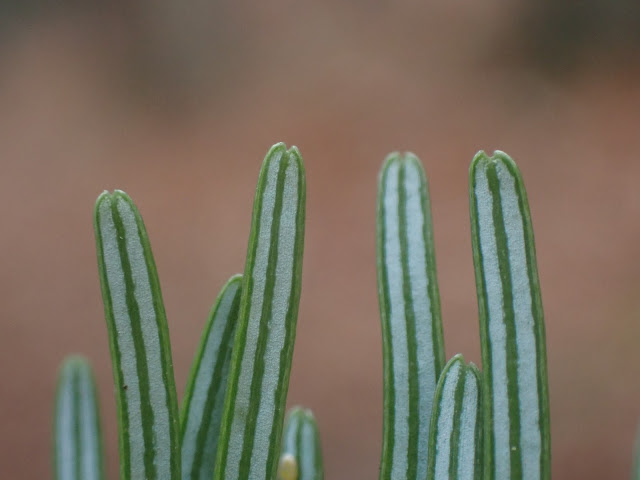
















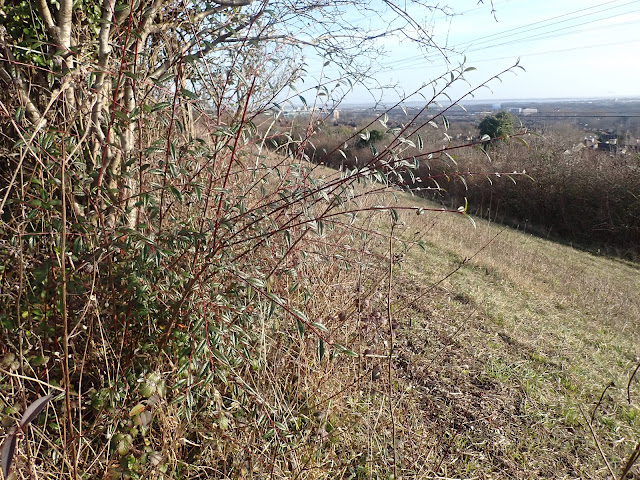

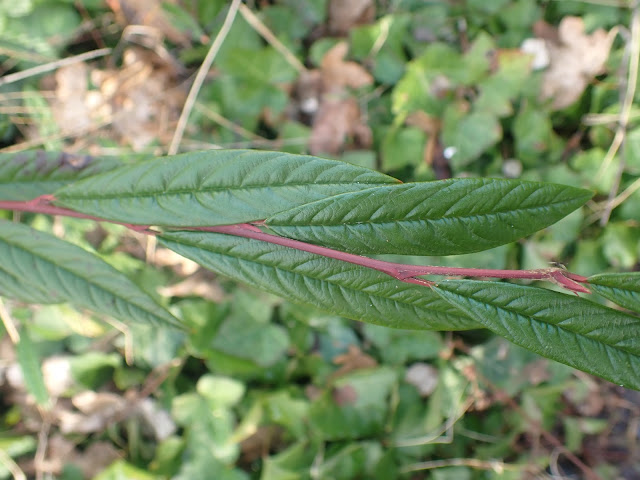













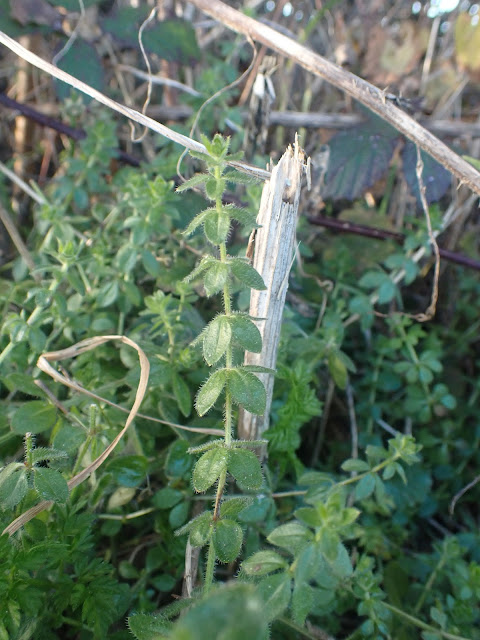









'Some knobber with his head stuck in a tree' - unlike the knobber who walked straight past the fungus and wandered round the tree wondering why he couldn't see it! And as for Summer Snowflake being a lifer, now you're just making stuff up!
ReplyDeleteWell this knobber didn't have the secret gen telling him it was INSIDE the tree, all you said was that it was "under the tree". What was I supposed to think, ya bloody knobber :D
DeleteNor did I, I just opened my eyes before charging off like a rhino :)
DeleteI only charged off like a rhino coz I was absolutely busting for a slash...
DeleteCan't believe I forgot to show you crosswort, and we must have walked past kilos of the stuff. Oh, well. Looks like a good trip
ReplyDeleteCertainly was! More bloggage to come once I get a spare few hours :)
Delete